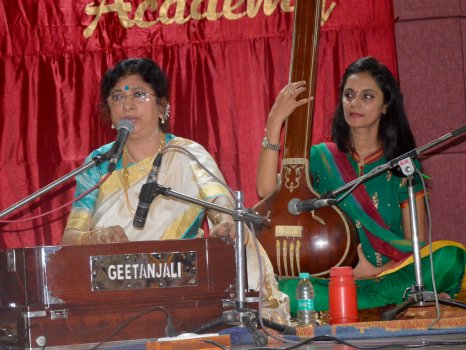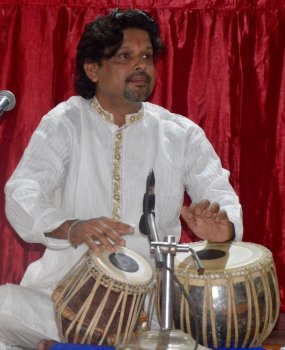
|   |

|   |
The mood of shringaar in monsoon - S.D. Desai e-mail: sureshmrudula@gmail.com October 12, 2015 Dekho piya to maanat naa...hi! There is no grumbling in this Thumri, liltingly rendered by Mitali Sengupta (Kolkata) at Aradhana Sangeet Academy’s four-day Monsoon Music Festival on its penultimate day (28 September, Ravishankar Bhavan). The Nayika is fondly in a mock complaining tone saying this to express her love for Piya! And she is saying it to the listeners so endearingly that, very pleased because they identify with the emotion, they smile and gently sway to the gently flowing lilt of the rendition. That’s the lyrical beauty in Indian Upashaastriya music! In its various forms, charmingly using delicate shabda, negative emotions - in most art forms, save theatre in a major way, in fact - rarely get expressed. In a Dadara, rendered next, the Nayika expresses her sweet uneasiness at being left in solitude by the lover: Tumhaare kaaran bikhare jiya... Torn, she pines for his comeback. The vocalist has trained under Girja Devi, who, Monica whispers, subtly lets rhythmic patterns other than Dadara creep in. Dr. Monica Hiren, herself a good vocalist, principal disciple of Dr Pradipta Ganguli, is the director and patient music teacher of Aradhana Academy. The academy has held around a hundred and eighty such programs of educative value for its members, most of them young, in the city known for its internationally reputed Saptak Music Festival. In the style and voice (slightly disturbed by travel) having had a perceptible influence of her guru, Mitali Sengupta then presented apane piya ko dhundan niksi … gagari bhool aayi..., a Poorvi Geet. Her dainty Kajari at the Monsoon Fest portrayed a playfully teasing, inviting Nayak in Shravan, Kaahe kar gumaan gori saavanme-n, chaal chal gori jhoom jhoom... !  The celebratory subdued shringaar mood of the vocalist who appeared to have a serious demeanor in the beginning turns cheerful in the Kajari and now Jhoola which has the Nayika, who likes being on the swing and yet endearingly asks her lover to be gentle in Dheere se jhulao banavaari samvariya... It has a sensitive listener swing with the rise and fall in the singing pattern and, at the same time, recall the pleasing images of Satyajit’s Charulata and Bimal. Mitali chose Chhota Khayal to take off initially and concluded her recital with a Bhajan.  Earlier, the young tabla player Bibhas Shanghai delighted the listeners with Ektaal, Tritaal and an innovative piece 'Tri-Taal', in which he combined Dhamaar, Jhaptaal and Tritaal. In these, and in bols as also in the sounds of trains crossing, he remained playful but did not play to the gallery. The contrasting rhythms in ‘Lom-Vilom’ were by way of ascending and descending sounds. In ‘Har-Gauri,’ he portrayed Parvati (Vama) with pleasingly soft sounds and Shiva with strong beats. The complementing sounds demonstrated the togetherness of the percussion pair. Unassumingly communicative and rather informal, with elements of unobtrusive dramatic sounds built in, and yet not deviating either from the technical accuracy nor from control and clarity, through considerable variations, he had an easy rapport with the appreciative listeners and drew intermittent applause. He later accompanied the vocalist. Other competent accompanists were Ikram Khan on the sarangi and Shishir Bhatt on harmonium. Dr. S.D. Desai, a professor of English, has been a Performing Arts Critic for many years. Among the dance journals he has contributed to are Narthaki, Sruti, Nartanam and Attendance. He guest-edited Attendance 2013 Special Issue. His books have been published by Gujarat Sahitya Academy, Oxford University Press and Rupa. After 30 years with a national English daily, he is now a freelance art writer. |